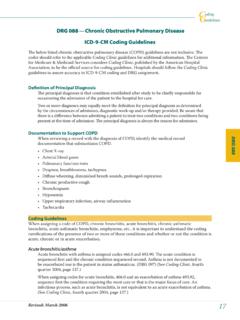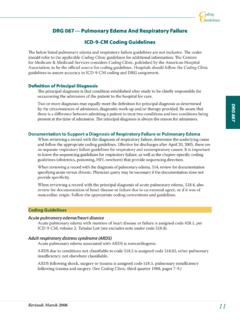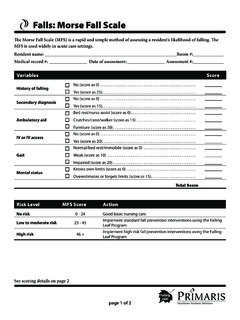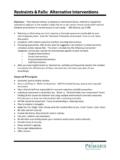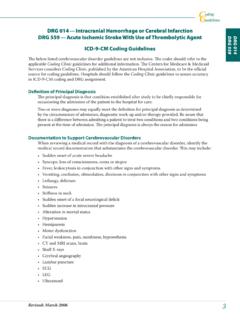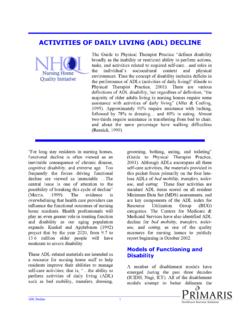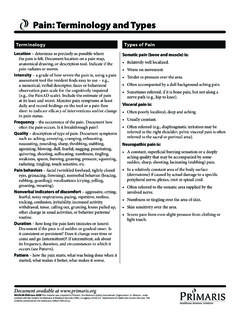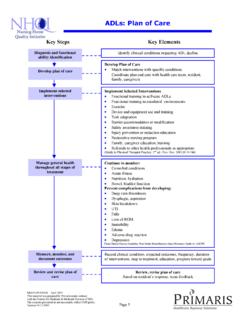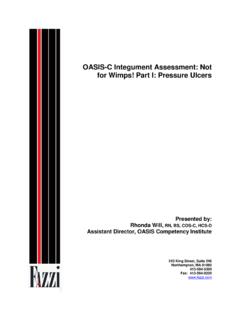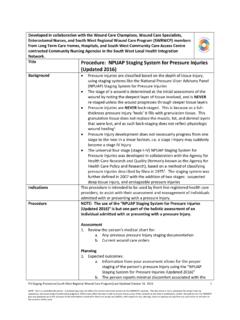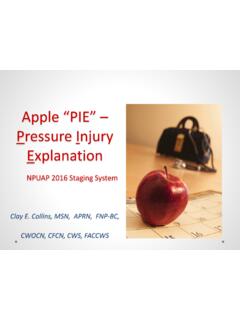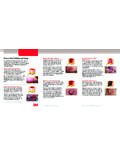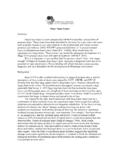Transcription of Pressure Ulcer Definition and Stages - Primaris
1 Pressure UlcerPressure UlcerPressure Ulcer Definition and StagesDefinition and StagesDefinition and Stages PR ESS UR E ULC E R STAGE SDEF INITI ON A Pressure Ulcer is localized injury to the skin and/or underlying tissue usually over a bony prominence, as a result of Pressure , or Pressure in combination with shear and/or friction. A number of contributing or confounding factors are also associated with Pressure ulcers; the significance of these factors is yet to be elucidated. Pressure ulcers are staged using the system at right. national Pressure Ulcer advisory Panel 1255 Twenty-Third Street NW, Suite 200 Washington, DC 20037 T: 202-521-6789 F: 202-833-3636 (SUSPECTED) deep tissue injury Purple or maroon localized area of discolored intact skin or blood-filled blister due to damage of underlying soft tissue from Pressure and/or shear.
2 The area may be preceded by tissue that is painful, firm, mushy, boggy, warmer or cooler as compared to adjacent tis sue. Further Description: deep tissue injury may be diffi cult to detect in individuals with dark skin tones. Evolution may include a thin blister over a dark wound bed. The wound may further evolve and become cov ered by thin eschar. Evolution may be rapid exposing additional layers of tissue even with optimal treatment. STAGE I Intact skin with non-blanchable redness of a localized area usually over a bony prominence. Darkly pig mented skin may not have visible blanching; its color may differ from the surrounding area.
3 Further Description: The area may be painful, firm, soft, warmer or cooler as compared to adjacent tissue . Stage I may be difficult to detect in individuals with dark skin tones. May indicate at risk persons (a heralding sign of risk). STAGE II Partial thickness loss of dermis presenting as a shallow open Ulcer with a red pink wound bed, without slough. May also present as an intact or open/ruptured serum-filled blister. Further Description: Presents as a shiny or dry shal low Ulcer without slough or bruising.* This stage should not be used to describe skin tears, tape burns, perineal dermatitis, maceration or excoriation. *Bruising indicated suspected deep tissue injury . STAGE III Full thickness tissue loss.
4 Subcutaneous fat may be vis ible but bone, tendon or muscle are not exposed. Slough may be present but does not obscure the depth of tissue loss. May include undermining and tunneling. Further Description: The depth of a stage III pres sure Ulcer varies by anatomical location. The bridge of the nose, ear, occiput and malleolus do not have sub cutaneous tissue and stage III ulcers can be shallow. In contrast, areas of significant adiposity can develop ex tremely deep stage III Pressure ulcers. Bone/tendon is not visible or directly palpable. STAGE IV Full thickness tissue loss with exposed bone, tendon or muscle. Slough or eschar may be present on some parts of the wound bed.
5 Often include undermining and tunneling. Further Description: The depth of a stage IV pres sure Ulcer varies by anatomical location. The bridge of the nose, ear, occiput and malleolus do not have sub cutaneous tissue and these ulcers can be shallow. Stage IV ulcers can extend into muscle and/or supporting structures ( , fascia, tendon or joint capsule) making osteomyelitis possible. Exposed bone/tendon is visible or directly palpable. UNSTAGEABLE Full thickness tissue loss in which the base of the Ulcer is covered by slough (yellow, tan, gray, green or brown) and/or eschar (tan, brown or black) in the wound bed. Further Description: Until enough slough and/or eschar is removed to expose the base of the wound, the true depth, and therefore stage, cannot be deter mined.
6 Stable (dry, adherent, intact without erythema removed. This staging system should be used only to describe Pressure ulcers. Wounds from other causes, such as arterial, venous, diabetic foot, skin tears, tape burns, perineal dermatitis, maceration or excoriation should not be staged using this system. Other staging systems exist for some of these conditions and should be used instead. or fluctuance) eschar on the heels serves as the body s natural (biological) cover and should not be Updated 02/2007 Copyright 2007
